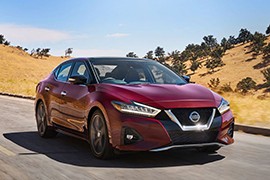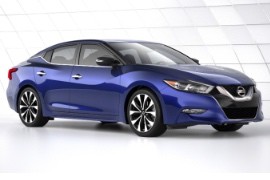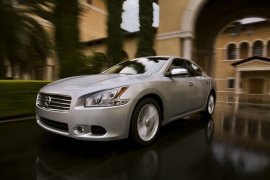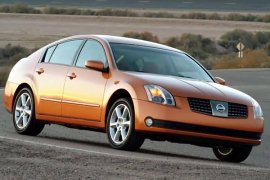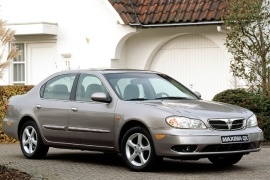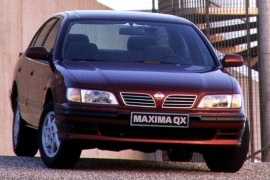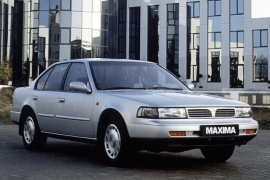NISSAN Maxima Models/Series Timeline, Specifications & Photos
First production year: 1989
Engines: Gasoline
The eighth generation of Nissan's flagship in the U.S. market went through a mild facelift in 2018. It was unveiled at the Los Angeles Auto Show.
The Nissan Maxima turned from a large sedan to a sport sedan. The car was unveiled in 2015 and it was improved to look like a sport sedan, despite being a front-wheel-drive vehicle. The mass distribution and the power to weight ratio were good.
The 2019 model-year featured new headlights with full-LED. The grille was reshaped and looked more aggressive than before. For the side view, the floating roof design was kept and enhanced with a minor chromed detail on the C-pillar. In the rear, new LED taillights were installed. The 19” light-alloy wheels have received a new design.
Inside, there was a new diamond design for the top trim level. Other than that, the 2019 Maxima offered more safety features in the Safety Shield 360 package. That included the Automatic Emergency Braking with Pedestrian Detection, Blind Spot Warning, Rear Cross Traffic Alert, Lane Departure Warning, High Beam Assist and Rear Automatic Braking. It was a standard fit for the Platinum and part of the SR Premium Package.
Under the hood, there was the same 300 hp 3.5-liter V6 engine mated to a CVT transmission. The steering and suspension were reworked for better cornering speed
The Nissan Maxima reached its eight-generation in 2015 when it was unveiled at the New York Auto Show. The presentation was made by the Renault-Nissan Alliance, Mr. Carlosh Ghosn.
There was a new, dramatic change in the car's design. Its whole concept was different than on its predecessor. The new design language included the V-Motion front end, boomerang lights, and C-pillars with floating roof appearance. It was an idea that was adopted from the smallest Micra model up to some of the Nissan SUVs.
Despite the increase in size when compared to the previous generation, the 2016 Maxima was lighter due to the use of aluminum on the hood, roof, and trunk lid. The new model was 2.2” (53.3 mm) longer and 1.3” (33 mm) lower than its predecessor, enabling sleeker styling and better aerodynamics.
For the interior, Nissan Maxima offered five trim levels, starting from the base S and going up to the top-line Platinum. The car could feature a panoramic roof, a new infotainment system with active sound enhancement, a premium 11-speaker Bose audio system and adaptive cruise control.
The new Maxima's 3.5-liter VQ-series V6 has been redesigned with more than 60 percent new parts (compared to the previous generation 3.5-liter V6). It offered 300 hp and it was mated with an Xtronic transmission, the Nissan's name for its CVT gearbox.
Nissan made the seventh generation of the Maxima as a sport sedan, shortening the wheelbase and increasing the tracks for both axles, thus increasing the car's handling.
Introduced in 2008, the Maxima A35 confirmed its status as a sportier, shorter sedan than its bigger sibling Altima. Nissan tried and convinced its customers that the Maxima was for families with spirited drivers, while the Altima was the mid-size sedan designed for comfort. The Maxima was more on the sports side in every technical detail and a few interior features.
The exterior look featured a catamaran-style front end, with two raised areas above the fenders and a bulge on the hood. Its wrapped-around headlights resembled those installed on the Z370, with their horizontal V-shape on their outer side. From its side, the cab-rearward design was classic for a rear-wheel-drive vehicle, but the Maxima was front-wheel-drive. At the back, the design team spoiled the car's, otherwise, sporty look with a large bumper, but the LED taillights smoothed the design.
Inside, the high-bolstered bucket seats at the front featured hand-stitched leather upholstery for the upper trim levels and promised good side support during high-speed cornering maneuvers. At the back, the carmaker added an option for heated seats and a separate climate control panel hidden in the center folding armrest. For the driver, Nissan installed a beautiful layout in the instrument cluster with a speedometer in the middle flanked by the tachometer on the left and the fuel and coolant temperature gauges. Chromed surroundings adorned the three-dial display.
Under the hood, Nissan installed the VQ35 engine that provided 290 hp, 35 more than its predecessor. It paired it with a CVT gearbox. The carmaker added a pair of paddle-shifters behind the steering wheel that selected six pre-set gears.
Nissan introduced the sixth generation of the Maxima lineup in 2003 as 2004 for most of the markets, including Australia and the U.S.
Introduced above the Altima lineup but sharing its underpinnings with it, the Maxima was already a known and appreciated vehicle. However, Nissan thought it could stand better against Honda's Accord and Toyota's Camry if it fit it with just one engine and thus decrease its production costs. Moreover, it added some unique features and, most importantly, it built it with independent suspension in all corners.
The rounded shape of the Maxima revealed a cab-rearward design, which left the impression of a rear-wheel-drive vehicle, but it wasn't. At the front, the Nissan 350Z-inspired headlights featured vertically mounted lamps and turn signals under the same clear lens. A vertical slat cut the grille in two, sporting the Nissan chromed badge. In addition, the carmaker added a unique feature for the car named SkyView, which was a fixed glass panel narrow and longitudinally mounted above the front and rear seats. At the back, the C-pillar was even thicker than on the previous generation, creating a stronger image for the vehicle.
Inside, Nissan offered the Maxima in two trim levels: SE and SL, with the former being the sportier and the latter its more luxurious sibling. In addition, the carmaker offered it with an option for four seats, with a center console that crossed the cabin from the dashboard to the seatback of the rear seat. Customers could choose between cloth or leather-wrapped seats with aluminum or wood trims.
Under the hood, both versions received a 3.5-liter V-6 powerplant paired with a standard five-speed automatic. The SE was available with an option for a six-speed close-ratio manual.
The fifth generation of the Maxima was a complete departure from its predecessor in terms of styling and powertrains and was also the last of its kind to be sold in Europe.
While in the U.S., it couldn't match the competition that came from Toyota with the Camry or the Legend from Acura (Honda in Europe), it tried to get a slice from the executive sedan segment. In the U.S., Maxima's platform has also been used by the Infiniti I30/I35.
While the biodesign era was coming to an end, making way for the new-edge styling that blended sharp lines with curved surfaces, Nissan's design studio still relied on the former shapes. The front fascia showed lines inspired by nature with the two-leafs design for the grille and headlights that mimicked a pair of eyes. For the U.S. market, the carmaker had to shrink the taillights and keep them only on the quarter panels. In Europe, on the other hand, it showed a slightly different styling out back, with more curved lines.
The interior followed the same ideas as the exterior, with curved lines that emerged from the center stack to the dashboard and rounded corners for the vents. The only angular shape was for the stereo installed above the climate control unit. While some still agreed with those lines, the sales figures showed that other carmakers made it better. Despite the comfortable cabin and decent room in the back, it was no match for most mid-size executive sedans on the market.
Under the hood, Nissan introduced an enhanced version of its already known 3.0-liter V6 from the previous generation. For the U.S. market, it also added the 3.5-liter six-mill powerplant that provided more grunt. In Europe, on the other hand, Nissan offered the Maxima with a 2.0-liter V6, more suitable for taxes but with sluggish performance.
Nissan released the fourth generation of the Maxima in May 1994, just in time to catch the Forrest Gump movie on the silver screen and earn the top spot in Ward's Best Engine.
Just like Forrest Gump, the Maxima was a long-distance runner with a strong, fuel-efficient engine. Nissan built it on a new platform and dropped the previously used rear independent suspension, which affected the rear-seat comfort. It was within the same price range as its main competitors, Honda Accord and Toyota Avalon, but slightly cheaper. With some help from the Cray supercomputer, Nissan's engineers found better solutions to stretch the 1995 Maxima and make it lighter.
Its exterior design featured a front fascia with sharp inner corners and softened edges for the headlights and a grille that mimicked angel wings (that's what Nissan said). The wrapped-around plastic bumper sported a black rubber strip to prevent scratches in the parking lot. It worked well against dumpsters as well. The cab-rearward design hid the front-wheel-drive transmission, while the optional rear wing spoiler warned the bystanders that the Maxima could run quite fast for its segment.
Inside, the base trim level featured cloth upholstery, a cassette player, power windows, and air-conditioning, but the leather seats, the Bose sound system, and the sunroof were on the options list. Its long wheelbase allowed comfortable seating for four, with a raised center tunnel to reinforce the bodywork.
The platform was the one that stood apart from the crowd. It featured urethane bushings at the front suspension and stiffer suspension, transforming the Maxima into a swift cornering machine. It's 0 to 60 mph (0-97 kph) in seven seconds flat was on the hot-hatch territory.
The third generation of the Maxima was launched in 1988 for the 1989 model year, and despite being offered with just one engine, it was a good bet for Nissan.
The mid-size segment in the U.S. market was already contested by most other carmakers, and it was dominated by Ford with the Taurus. Still, Nissan didn't drop the ball and launched the Maxima as a serious contender for the blue-oval brand. It did that by completely redesigning its flagship model for the American market and fitting it with all the amenities it had in its basket.
Nissan pushed the limits of its marketing strategy by calling the Maxima a four-door sports car, but that wasn't entirely an overstatement. Its front fascia with horizontal, rectangular headlights resembled some of the sports cars from that era. Moreover, the aerodynamically profiled bumper featured some additional air intakes and sported the parking lights and the foglights below. The flowing lines of the bodywork were an important step forward in Nissan's design strategy, which ditched the wedged shapes sported by the previous generation. In addition, the blackened B-pillar left the impression of a two-door vehicle, while the body-colored flush door handles amplified that image. Finally, depending on the option, the carmaker installed a wing on the trunk, emphasizing the car's sports-oriented profile.
The greenhouse's shape was a trade-off for the rear passenger's headroom, but that was a problem only for adult occupants. With its cloth-upholstered front bucket seats that provided adequate side support, the Maxima delighted its drivers and its passengers. In addition, the flowing lines on the dashboard complemented by the white dials in the instrument cluster created a pleasant ambiance.
Nissan installed its 3.0-V6 single-cam engine under the car's hood. It was similar to the one available in the 300ZX sports car. Thanks to its independent suspension and four-wheel anti-lock disc brakes, the Maxima confirmed Nissan's statement about the four-door sports sedan.
